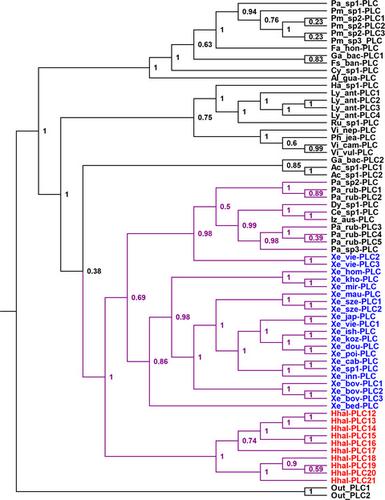当前位置:
X-MOL 学术
›
Ecol. Evol.
›
论文详情
Our official English website, www.x-mol.net, welcomes your
feedback! (Note: you will need to create a separate account there.)
Tripartite parasitic and symbiotic interactions as a possible mechanism of horizontal gene transfer
Ecology and Evolution ( IF 2.3 ) Pub Date : 2021-04-06 , DOI: 10.1002/ece3.7550 Chaoyang Zhao 1 , Shaoming Miao 2 , Yanfang Yin 2 , Yanjuan Zhu 2 , Paul Nabity 1 , Raman Bansal 3 , Chenxi Liu 2
Ecology and Evolution ( IF 2.3 ) Pub Date : 2021-04-06 , DOI: 10.1002/ece3.7550 Chaoyang Zhao 1 , Shaoming Miao 2 , Yanfang Yin 2 , Yanjuan Zhu 2 , Paul Nabity 1 , Raman Bansal 3 , Chenxi Liu 2
Affiliation

|
Herbivory is a highly sophisticated feeding behavior that requires abilities of plant defense suppression, phytochemical detoxification, and plant macromolecule digestion. For plant-sucking insects, salivary glands (SGs) play important roles in herbivory by secreting and injecting proteins into plant tissues to facilitate feeding. Little is known on how insects evolved secretory SG proteins for such specialized functions. Here, we investigated the composition and evolution of secretory SG proteins in the brown marmorated stink bug (Halyomorpha halys) and identified a group of secretory SG phospholipase C (PLC) genes with highest sequence similarity to the bacterial homologs. Further analyses demonstrated that they were most closely related to PLCs of Xenorhabdus, a genus of Gammaproteobacteria living in symbiosis with insect-parasitizing nematodes. These suggested that H. halys might acquire these PLCs from Xenorhabdus through the mechanism of horizontal gene transfer (HGT), likely mediated by a nematode during its parasitizing an insect host. We also showed that the original HGT event was followed by gene duplication and expansion, leading to functional diversification of the bacterial-origin PLC genes in H. halys. Thus, this study suggested that an herbivore might enhance adaptation through gaining genes from an endosymbiont of its parasite in the tripartite parasitic and symbiotic interactions.
中文翻译:

三方寄生和共生相互作用作为水平基因转移的可能机制
草食是一种高度复杂的摄食行为,需要植物防御抑制、植物化学解毒和植物大分子消化的能力。对于吸食植物的昆虫来说,唾液腺(SG)通过分泌蛋白质并将蛋白质注入植物组织以促进取食,在食草中发挥着重要作用。关于昆虫如何进化出分泌性 SG 蛋白来实现这种特殊功能,人们知之甚少。在这里,我们研究了棕色斑纹臭蝽 ( Halyomorpha halys ) 中分泌性 SG 蛋白的组成和进化,并鉴定了一组与细菌同源物具有最高序列相似性的分泌性 SG 磷脂酶 C (PLC) 基因。进一步的分析表明,它们与致病杆菌 (Xenorhabdus)的PLC关系最为密切,致病菌是一种与昆虫寄生线虫共生的伽马变形杆菌属。这些表明H. halys可能通过水平基因转移 (HGT) 机制从致病杆菌那里获得这些PLC ,这可能是由线虫在寄生昆虫宿主期间介导的。我们还表明,最初的 HGT 事件之后是基因复制和扩展,导致H. halys中细菌来源的 PLC 基因的功能多样化。因此,这项研究表明,食草动物可能通过在三方寄生和共生相互作用中从其寄生虫的内共生体中获得基因来增强适应能力。
更新日期:2021-04-06
中文翻译:

三方寄生和共生相互作用作为水平基因转移的可能机制
草食是一种高度复杂的摄食行为,需要植物防御抑制、植物化学解毒和植物大分子消化的能力。对于吸食植物的昆虫来说,唾液腺(SG)通过分泌蛋白质并将蛋白质注入植物组织以促进取食,在食草中发挥着重要作用。关于昆虫如何进化出分泌性 SG 蛋白来实现这种特殊功能,人们知之甚少。在这里,我们研究了棕色斑纹臭蝽 ( Halyomorpha halys ) 中分泌性 SG 蛋白的组成和进化,并鉴定了一组与细菌同源物具有最高序列相似性的分泌性 SG 磷脂酶 C (PLC) 基因。进一步的分析表明,它们与致病杆菌 (Xenorhabdus)的PLC关系最为密切,致病菌是一种与昆虫寄生线虫共生的伽马变形杆菌属。这些表明H. halys可能通过水平基因转移 (HGT) 机制从致病杆菌那里获得这些PLC ,这可能是由线虫在寄生昆虫宿主期间介导的。我们还表明,最初的 HGT 事件之后是基因复制和扩展,导致H. halys中细菌来源的 PLC 基因的功能多样化。因此,这项研究表明,食草动物可能通过在三方寄生和共生相互作用中从其寄生虫的内共生体中获得基因来增强适应能力。











































 京公网安备 11010802027423号
京公网安备 11010802027423号